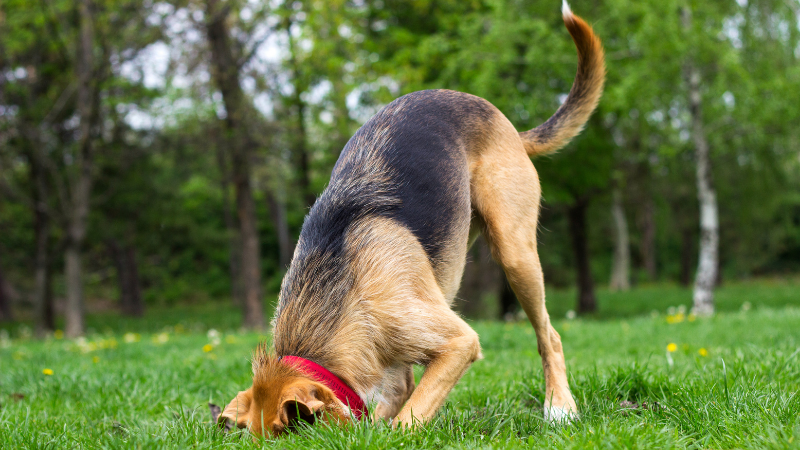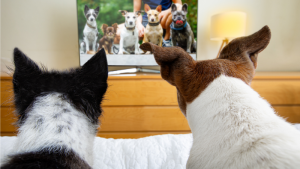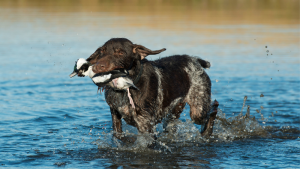Often, a destructive dog is a bored dog. One that isn’t being stimulated mentally and is using the destructive behavior to lessen their boredom and fulfil their drives. In general, to stop destructive behaviors you should first make sure that your dog is being mentally stimulated, is getting enough exercise for their breed, and that they have a productive outlet instead.
I have two rescue huskies. I’ve tried just about every method to curb their destructive behaviors from digging, chewing, and escaping. I learned a lot over the years and the most surprising thing I learned was that it didn’t seem to matter how much I corrected them, they still did they behaviors until I learned to satisfy their drives in different ways. Sure, they stopped chewing up things they knew they shouldn’t be chewing in front of me after consistent training and corrections, but when I left the room all bets were off.
Here’s some of my favorite methods and tips for satisfying destructive dog drives in more productive ways.
1. Dog Toys for Aggressive Chewers
There are lots of toys out on the market designed for chewing. These will last a considerable amount of time and will ensure that your dog has something that he or she CAN chew on. Kong and other manufacturers make chew toys for every size. If your dog is an aggressive chewer, you’ll want to make sure you’re getting a toy that can stand up to the chewing. Otherwise, you’ll be cleaning up toys scraps and cotton up in a matter of seconds.
These toys for aggressive chewers are often hard and durable, but sometimes they have soft outsides and hard rope insides. These are some of my favorite toys for my huskies because they hold up much better than the average dog toy, but I can still give my dog something that looks like the stuff animals that they love. Before I found these toys, my kids had several animals become casualties to my huskies.
Now that you have these toys, offer them to your dog as soon as you see them start chewing on something they shouldn’t. A firm correction about the incorrect item, then praise and attention for the correct item should teach your dog what they are and are not allowed to chew on. As soon as you give your dog a productive alternative to the furniture, they will take it. You can also make the toys even more tempting by adding dog-safe peanut butter and other products to them when they toys allow for it.
2. Bad Behaviors to Get Attention
Your dog may also be chewing furniture as a way to get your attention. While this is only going to get your dog undesirable attention, he or she does not know that right away. This means that you have to say “No” in a very firm voice so that your dog understands that chewing the furniture is inappropriate behavior then ignore your dog so they aren’t accidentally rewarded for the bad behavior. Wait for them to stop their bad behavior, then shower them with tons of positive attention while they are being good.
It’s important to have a united force in the house. If you live with others, make sure that everyone takes the same approach with your dog. You don’t want one person saying one thing and someone else saying something else. Everyone needs to tell your dog the same thing so that your dog will learn that he or she is not supposed to be chewing on the furniture, electronics, child toys, or anything else.
3. Spray for Furniture
If you have bought your dog chew toys and disciplined them but they are still chewing, there are sprays that you can buy in the pet store that can be sprayed on the furniture. This is essentially a disgusting-tasting spray that will discourage them from chewing on the couch, dining room chair or anything else. If you are going to take this route, be sure to spray it on everything, otherwise they will just move from one piece of furniture to the next.
Your dog probably doesn’t know that they aren’t allowed to chew on the furniture. Most dogs want to act accordingly, so it is up to you to be sure your dog knows what proper behavior is. After a few weeks of discipline, it should get better so that you can save your furniture from canine destruction.
4. Puzzle Toys
Some dogs will chew on the furniture, but also don’t seem interested in the chew toys their owners bring home. In these cases, it could be that your dog is looking for mental stimulation instead. Puzzle toys are a great way to keep your dog busy for hours as they work to try and figure out how to get the treats out.
There are several different puzzle toys out there. Some are fairly easy for your dog to figure out, and some are very hard and seem nearly impossible. When starting out, I’d recommend getting a couple on the easier end to help teach your dog the concept of puzzle toys and then moving up to harder ones that’ll keep the game going for longer. If you start with a hard puzzle toy and your dog isn’t able to get a treat after trying for a while, they may not understand the concept and give up on the puzzle toys all together.
5. Are they Getting enough Exercise?
A dog with to much energy is usually going to cause trouble. They may be overly energetic at home and hard to handle. They may dig holes in the yard, chew and scratch up the house, bark excessively, or other non-desirable behaviors. Before taking other methods to correct some of these behaviors, simply taking your dog on more walks or runs may help.
It can be hard sometimes to keep on top of exercise, but it can make a ton of difference in the behavior of your dog. All dogs have different exercise needs. Some breeds aren’t as active and short walks are perfect. Other breeds could run for miles and still want to run more. Puppies are usually higher energy, but you should be careful with their exercise since they aren’t fully developed and too much running could be bad for them.
6. Mentally Stimulating Walks
Some dogs are really smart and they need more than just new toys to curb their boredom, but also something that mentally challenges and stimulates them. I remember one time during a group dog training session one of the owners said that their dog was out of control and they couldn’t figure out why. They said that they’d been running for hours each morning and night, and their dog still had a ton of energy and was chewing and digging up everything he could get his paws on.
Our trainer said that even though they’d been physically exercising their dog, they hadn’t been giving him a mental outlet too. He said that they should try to slow down at least part of the run, and let their dog lead the way. Let their dog sniff around and explore the new area to his content. This should allow their dog a mental outlet in addition to a physical one.
The next day, they reported that slowing dog the walks had made a noticeable difference. Their dog had been much calmer at home. Even sleeping for several hours after a walk.
7. Playing Fetch as an Alternative for Walks
You don’t always have to go on a walk, hike, or run to exercise your dogs. Some dogs will go crazy for fetch and can tire themselves out this way as well. Plus, a huge benefit of fetch is that you can stay in one spot and through the ball, while they put in the miles running back and forth. This is a great way to exercise your dogs on days when you’re just not feeling up for a walk.
They also have nifty toys that can through the ball for you. Although, if you always use one of these your dogs will miss the opportunity to bond with you during games as well.
8. At-Home Treasure Hunt
When I know I’m going to be gone for longer than usual, I like to set up a treasure hunt for my dogs while I’m out. It’s easy, I just hide some of their treats around the house and then they can spend their day hunting down the treats instead of destroying my house.
When I first started, I basically just step the treats in random places throughout the house. However, as my dogs got more familiar with the concept I was able to hide the treats in more challenging ways.
Be careful with where you hide the treats though. If you don’t want your dog chewing up your couch, then you probably shouldn’t hide a treat under the cushions.
9. Safe Place for Backyard Digging
Some dogs are big diggers who want to dig all the time just for fun. Some dogs are more productive diggers who dig when they want to create a good spot for laying or when they think they smell something underground. And some dogs don’t really seem interested at all.
Digging can be a hard behavior to stop, since they usually dig when they’re out in the yard alone. Some people suggest tricks like putting dog poop in the hole to prevent digging, as dogs don’t like playing with their own poop. This might work for you, but I didn’t have a lot of success with this method perfectly.
What I did instead, was give in. I chose a couple spots in my yard, based on where some of the previous digging had happened, and designated them as dig zones. I stopped filling in the holes here and started praising my dogs when they dug in those spots instead of the rest of the yard. Yes, I still have a few holes in my yard, but they’re now where I can control and I’m not at risk of breaking my leg in a surprise hole.
When I started trying to get rid of my dog’s digging behaviors, I thought they were huge diggers. It seemed like everytime I covered up a hole, they’d dig two more to replace it. However, once I gave my dogs a place for them to dig and stopped filling in the holes, they stopped most of their digging. It turns out that they really just wanted a couple big holes that they could lay in during the day, but they didn’t really care to have a million.
While I was running around covering all their holes I was actually making them dig more to replace their laying spot that they’d made. This is a classic case of dog-owner miscommunication. My dogs were probably thinking, “Come on mom, can’t I just have one hole to lay in. Then I’ll stop digging.” While I was running around thinking, “OMG every time I cover up one hole they just dig more. When will it stop. If I don’t fill in all these holes now, soon my entire yard will just be one giant hole.”
10. Working with a Qualified Trainer
If you’ve tried the above methods to mentally and physically stimulate your dog, but nothing seems to be working, then it’s probably time to work with a certified trainer. They will help you understand your dog’s particular drives and behaviors and work with you to develop a training plan that will help resolve their undesirable behaviors.
What are your tricks for curbing bad behaviors in dogs? Share with us in the comments below.




